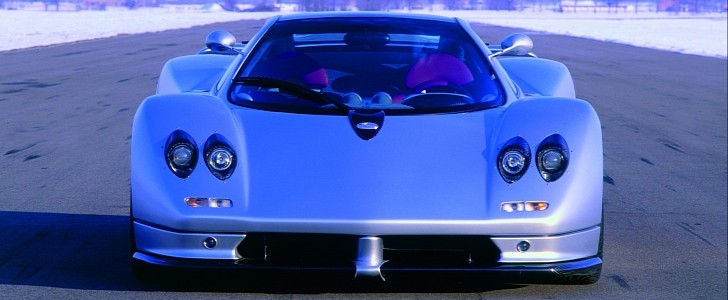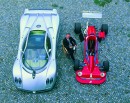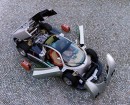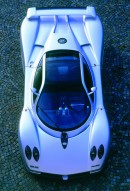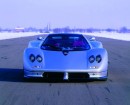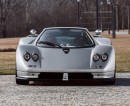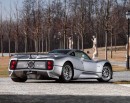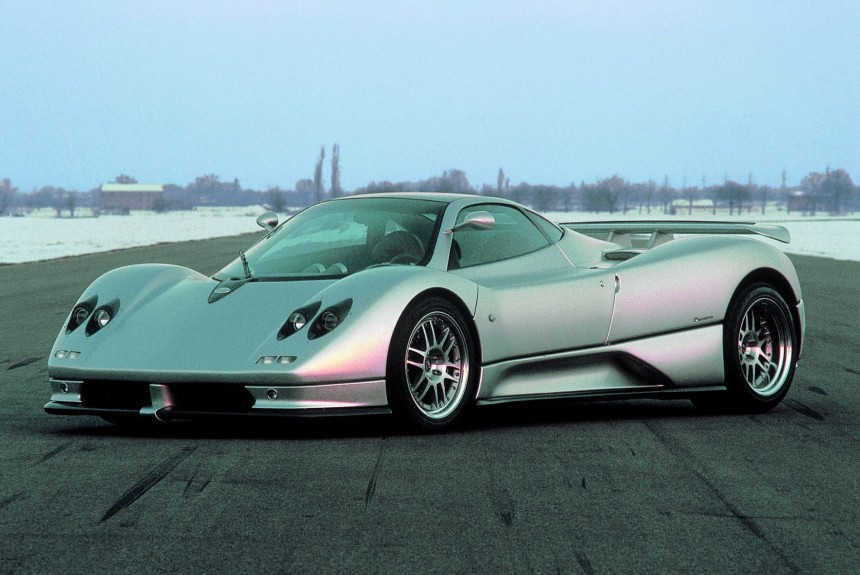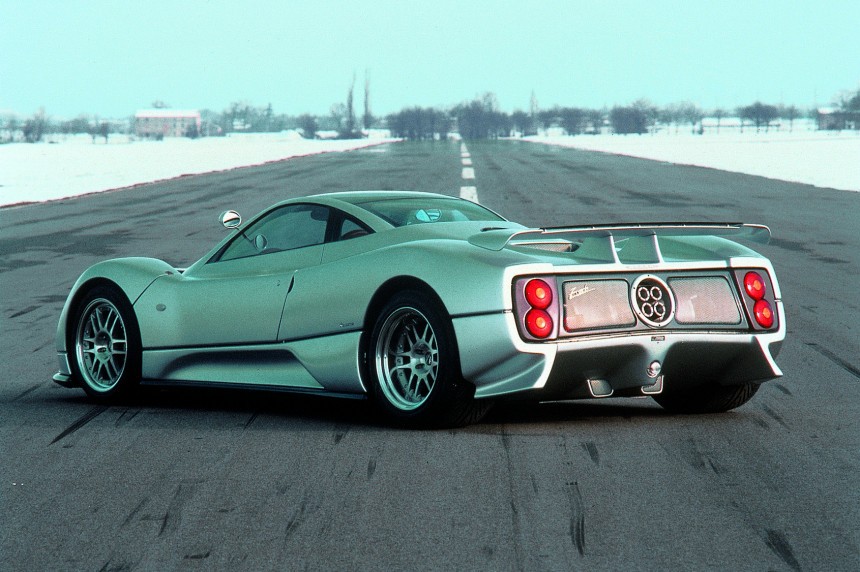The first supercar developed and produced at San Cesario sul Panaro, the Zonda wouldn't have been possible without Horacio’s devotion to all things mechanical and his appreciation for all things beautiful. When he was just a kid, the founder of Pagani Automobili used to spend time at a local modeler’s shop, where he learned useful techniques by observing Adolfo “Tito” Ispani working on aeronautical and naval projects.
Some of his earliest works, from when Horacio was 12 years old, are preserved in a display case at Pagani’s headquarters in Modena. The Argentine-Italian engineer and businessman would gain a plethora of valuable knowledge during his eight-year stint at Automobili Lamborghini.
Directly involved in the P140 project that would have been the Raging Bull’s first V10 supercar had it made it to production, this gentleman and his team were also responsible for the Countach Evoluzione, the first car manufactured entirely out of composite materials to come out of Sant’Agata Bolognese.
The story goes that Horacio bought an autoclave at his own expense, a decision that laid the groundwork for the Zonda. His best-known work from the Lamborghini era, however, is the Countach 25th Anniversary that was made famous by that infamous scene in the Wolf of Wall Street.
Due to Lambo’s financial issues, a Chrysler group that wasn’t doing too well, and early 1990s recession that affected much of the Western world, Horacio made the bold move to steer his passion and purpose somewhere else. Although those were troubled times, Mr. Pagani decided to give life to his lifelong dream of developing a supercar that would bear his name.
To finance this extremely ambitious project, he founded a consultancy firm by the name of Modena Design in 1991, specializing in carbon-fiber composites for the automotive industry, Formula 1, and the aerospace industry. One year later, in 1992, Pagani Automobili Modena was founded for the sole purpose of taking the Zonda project from the drawing board to the road.
Originally called the C8, Horacio intended to rename this project Fangio F1 in honor of the five-time Formula 1 champion from his native country. None other than Juan Manuel Fangio suggested Mercedes power for what would be presented as the Pagani Zonda C12 at the 1999 Geneva Motor Show.
Inspired by Group C Silver Arrows such as the Sauber C9 and Mercedes-Benz C291, “the sinuosity of a curvy woman,” and the menacing look of a fighter bomber, the Zonda makes liberal use of advanced composite materials. The carbon-fiber tub measures 2,730 millimeters between the front and rear axles, offering more than enough space for the driver and passenger while providing exceptional protection in the event of a crash.
Chrome molybdenum steel is used for the subframes, with the front unit designed to deform in the event of a crash. Double wishbones on every corner, manufactured from lightweight aluminum alloy, are joined by helicoidal springs, hydraulic dampers, anti-roll bars, and trick geometry.
Brembo-supplied brakes, no ABS whatsoever, and OZ Racing 18-inch wheels that measure 13 inches in width out back also need to be mentioned, along with Michelin rather than Pirelli tires. Right behind the driver’s ears, a naturally-aspirated V12 supplied by the Three-Pointed Star of Stuttgart sings the song of its people through a uniquely styled quad-tip exhaust.
Codenamed M120, the 60-degree V12 that powered the Mercedes-Benz S 600 from the W140 generation uses lightweight aluminum alloy for the block and both cylinder heads. Displacing 5,987 cubic centimeters from an 89-millimeter bore and 80.2-millimeter stroke, the Pagani-specific M120 lump is fed by a fuel tank with a capacity of 85 liters (22.4 U.S. gallons).
444 horsepower at 5,200 revolutions per minute and 435 pound-foot (590 Nm) of torque at 3,900 revolutions per minute allowed the Zonda C12 to accelerate to 62 miles per hour (100 kilometers per hour) in 4.2 seconds. Top speed? 298 kilometers per hour (185 miles per hour), thank you! The dry weight was quoted at 1,250 kilograms (2,756 pounds), which is far off the McLaren F1 but noticeably lighter than the Lamborghini Diablo.
Only five cars were completed, with the first chassis restored by Mr. Pagani to celebrate the 20th anniversary of the Zonda. Presented one year after the C12, the C12 S leveled up to 7.0 liters of V12 magic. The extra displacement obviously lifted the output ratings to 542 ponies at 5,550 revolutions per minute and 553 pound-foot (750 Nm) at 4,100 revolutions per minute.
Visually differentiated by the updated aero, the Zonda C12 S would be produced in merely 15 examples. Not designated C12 like its predecessors, the Zonda S 7.3 marked the final increase in displacement for the Italian supercar from San Cesario sul Panaro. Merely a year after it was introduced, the Zonda S 7.3 was joined by a roadster at the 2003 Geneva Motor Show.
It may weigh 30 kilograms (66 pounds) more than the coupe, yet both of them boast similar top speed and acceleration figures. The roadster’s introduction also marked the introduction of 19-inch wheels. Prior to the introduction of the Zonda F at the 2005 Geneva Motor Show, the Italian company delivered 18 units of the Zonda S 7.3 coupe and 12 roadsters.
Directly involved in the P140 project that would have been the Raging Bull’s first V10 supercar had it made it to production, this gentleman and his team were also responsible for the Countach Evoluzione, the first car manufactured entirely out of composite materials to come out of Sant’Agata Bolognese.
The story goes that Horacio bought an autoclave at his own expense, a decision that laid the groundwork for the Zonda. His best-known work from the Lamborghini era, however, is the Countach 25th Anniversary that was made famous by that infamous scene in the Wolf of Wall Street.
Due to Lambo’s financial issues, a Chrysler group that wasn’t doing too well, and early 1990s recession that affected much of the Western world, Horacio made the bold move to steer his passion and purpose somewhere else. Although those were troubled times, Mr. Pagani decided to give life to his lifelong dream of developing a supercar that would bear his name.
To finance this extremely ambitious project, he founded a consultancy firm by the name of Modena Design in 1991, specializing in carbon-fiber composites for the automotive industry, Formula 1, and the aerospace industry. One year later, in 1992, Pagani Automobili Modena was founded for the sole purpose of taking the Zonda project from the drawing board to the road.
Originally called the C8, Horacio intended to rename this project Fangio F1 in honor of the five-time Formula 1 champion from his native country. None other than Juan Manuel Fangio suggested Mercedes power for what would be presented as the Pagani Zonda C12 at the 1999 Geneva Motor Show.
Chrome molybdenum steel is used for the subframes, with the front unit designed to deform in the event of a crash. Double wishbones on every corner, manufactured from lightweight aluminum alloy, are joined by helicoidal springs, hydraulic dampers, anti-roll bars, and trick geometry.
Brembo-supplied brakes, no ABS whatsoever, and OZ Racing 18-inch wheels that measure 13 inches in width out back also need to be mentioned, along with Michelin rather than Pirelli tires. Right behind the driver’s ears, a naturally-aspirated V12 supplied by the Three-Pointed Star of Stuttgart sings the song of its people through a uniquely styled quad-tip exhaust.
Codenamed M120, the 60-degree V12 that powered the Mercedes-Benz S 600 from the W140 generation uses lightweight aluminum alloy for the block and both cylinder heads. Displacing 5,987 cubic centimeters from an 89-millimeter bore and 80.2-millimeter stroke, the Pagani-specific M120 lump is fed by a fuel tank with a capacity of 85 liters (22.4 U.S. gallons).
Only five cars were completed, with the first chassis restored by Mr. Pagani to celebrate the 20th anniversary of the Zonda. Presented one year after the C12, the C12 S leveled up to 7.0 liters of V12 magic. The extra displacement obviously lifted the output ratings to 542 ponies at 5,550 revolutions per minute and 553 pound-foot (750 Nm) at 4,100 revolutions per minute.
Visually differentiated by the updated aero, the Zonda C12 S would be produced in merely 15 examples. Not designated C12 like its predecessors, the Zonda S 7.3 marked the final increase in displacement for the Italian supercar from San Cesario sul Panaro. Merely a year after it was introduced, the Zonda S 7.3 was joined by a roadster at the 2003 Geneva Motor Show.
It may weigh 30 kilograms (66 pounds) more than the coupe, yet both of them boast similar top speed and acceleration figures. The roadster’s introduction also marked the introduction of 19-inch wheels. Prior to the introduction of the Zonda F at the 2005 Geneva Motor Show, the Italian company delivered 18 units of the Zonda S 7.3 coupe and 12 roadsters.
